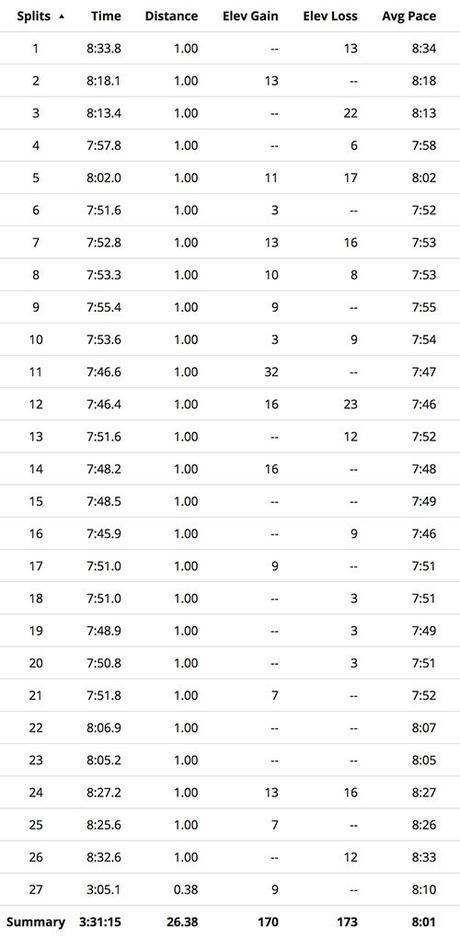A boy’s story is the best that is ever told.
– Charles Dickens
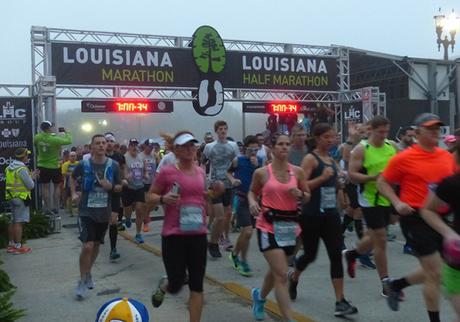
State 15 would beckon from
a land of purple & gold,
The next chapter in our story
and each chapter must be told…
The scene felt eerily lifted from a dystopian sci-fi film. As if of one mind, bodies like drowsy ants moved slowly but purposefully toward the start line. The hulking shadow of the nation’s tallest state capitol building loomed in the background, its dimly lit tower shrouded by the gray morning fog.
This was race day weather different than any I’d experienced before—foggy and yet strangely humid. Anyone who didn’t keep track of such things wouldn’t have guessed that just seven days earlier and 175 miles to the northeast, the Mississippi Blues Marathon in that state’s capital city of Jackson had been canceled by freezing rain and icy conditions.
Welcome to winter in the Deep South.
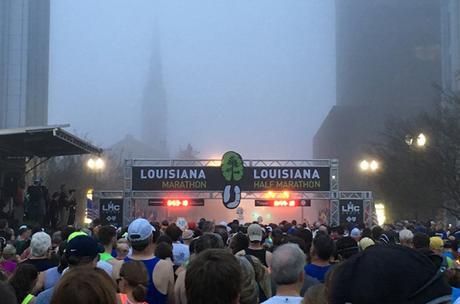
Into the fog: One minute to “go” time (the state capitol is out of the picture behind us)
By contrast, here in Baton Rouge we’d apparently lucked out. Cloudy skies were expected to prevail until at least noon, and all signs pointed to ideal race day conditions. In our customary fashion Katie and I had arrived—after a ten-minute walk from our hotel—within 15 minutes of the official 7:00am start. That left me plenty of time to sidle my way to the front of the loosely packed start corral, where I found new friends James and Joey lined up ready to roll. Literally.
James and Joey (Team JoJo) would be taking part in the Louisiana Half Marathon as Ainsley’s Angels, a group that “aims to build awareness about America’s special needs community through inclusion in all aspects of life”. I’d first been introduced to Joey online and learned of his story through Mike B, a Bay Area friend who’d met the boy through “I Run For Michael”, a Facebook group that pairs able-bodied and special needs athletes.
Mike runs for Joey because Joey can’t run for himself. Joey has cerebral palsy but—as Mike likes to say—it doesn’t have him. He recently underwent Selective Dorsal Rhizotomy (SDR) surgery to reduce the spasticity in his lower body, a breakthrough procedure that has enabled him to walk and even run short distances. Nevertheless, his is a daily battle fought with the love and support of his dad James, mom Jessica and sister Abi.
But if you think having special needs earns him your pity, you’d be wrong. Joey is like any other 7-year-old boy—bursting with energy and eager to show off. When Katie and I met him and has family at the expo on Saturday, he kept us laughing with his infectious smile and carefree goofiness.
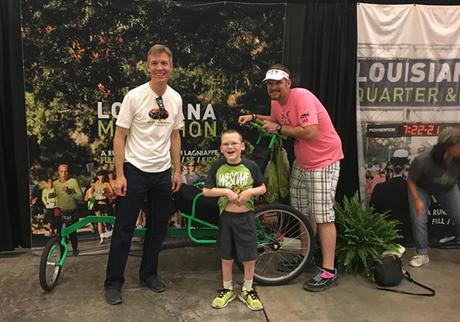
Joey shows off his Iron Man-like abs at the pre-race expo (dad James is at right)
And as it turns out, Joey loves to race. Apparently, after seeing an Ironman competition on television one day, he let it be known that that’s what he wanted to do. So at the urging of his son (and because that’s what awesome dads do), James trained his body into triathlete shape and now regularly pushes his athlete-rider son in a specially designed racing chair reminiscent of Boston’s legendary father-son duo of Dick and Rick Hoyt.
With start time fast approaching in Baton Rouge, Team JoJo looked ready to roll alongside a couple dozen other teams of Ainsley’s Angels. I wished them both good luck before falling back to take my place among the 3:45 pace group.
The Mayor/President-elect of Baton Rouge said a few words of welcome over the PA, and with five days to go until the inauguration of our 45th President, who can say whether she was referencing the current political unease when she quoted Kathrine Switzer: “If you are ever losing faith in human nature, go out and watch a marathon.”

The Horace Wilkinson Bridge spans the mighty Mississippi, with the USS Kidd in the foreground
Under cloudy humid skies this day
there’d be no winter cold
(All the details that matter
to the story must be told).
After a National Anthem sung by a fellow runner whose goal is to sing in all 50 states, we were off on what for most of us would be our first marathon of 2017. The first few miles flew by quickly, as the first few miles of a marathon typically do. With little to see thanks to the lingering fog, I took the opportunity to gather my thoughts and plan out my strategery for the next 3+ hours.
My goal for the day was simple: my training plan called for 13 miles at a pace of 8:08/mile, meaning I’d give myself three slower miles to warmup before kicking it up to an 8:08/mile pace. I’d then maintain that pace until mile 16, where I’d re-evaluate and hopefully take the last 10 miles to pat myself on the back. No pressure.
The fog persisted as though it had something to hide, and it struck me how little of Baton Rouge I was seeing. We’d begun our visit 36 hours earlier in a similar manner, entering the town under cover of darkness after making the late-night drive from New Orleans. All I’d been able to spy in the way of scenery had been the shadowy skeletons of trees lining both sides of the highway, and my brain had conjured up spooky imagery to fill in the gaps created by the blackness. In our rental car “Far From Any Road”, the haunting theme song to HBO’s gritty True Detective, served as our soundtrack welcoming us to Louisiana.
Back on course, I was feeling great despite the odd winter humidity, and was having no trouble holding an 8:08/mile pace. In fact, on several occasions I had to consciously slow down to avoid dipping down into the 7:40s. Given that 2016 had been a slowdown year for me with zero sub-3:30 marathons, it was comforting to be able to hold an ~8:00/mile pace easily.
Running south in a literal haze we passed The Book Exchange, one of the few edifices I could make out and the most dilapidated building we’d see all day. The store looked abandoned to say the least, as though it had exchanged its last book sometime during the Eisenhower administration.
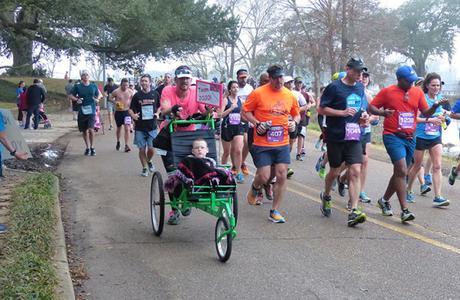
Team JoJo looking strong in mile 9
Teams of Ainsley’s Angels were out on the course providing plenty of inspiration, and I clapped and cheered as I passed James and Joey on a slight incline in mile 3. James ran with a smile on his face while Joey stared straight ahead, keenly focused on the task at hand. And though I’d miss seeing them again as they’d finish an hour before me, father and son would celebrate their 13.1-mile accomplishment with Joey crossing the finish line on his own two legs—legs that I have no doubt will cross a lot more finish lines in the future. Congrats, Team JoJo!
Continuing along Park Blvd, the sprawling oaks lining each side of the street formed an extended “tree tunnel” that would have offered much-needed shade on a warm day. The green expanses of Baton Rouge City Park swept by, followed by City Park Lake, which seemed to morph almost seamlessly into the creatively named University Lake that borders the Louisiana State University (LSU) campus.
We hit the mile 5 marker outside what I’d guess is the centerpiece of the campus and the most popular center of worship in Baton Rouge—Tiger Stadium, which hosts the football team and undoubtedly as many LSU faithful as it can fit during the football season. I’ve said it before—I’m a sucker for a good college campus, and certainly the opportunity to run around and through the LSU campus may have influenced my choice of Louisiana marathons (that and not liking New Orleans). Like Austin, Baton Rouge is a college town moonlighting as a state capital.
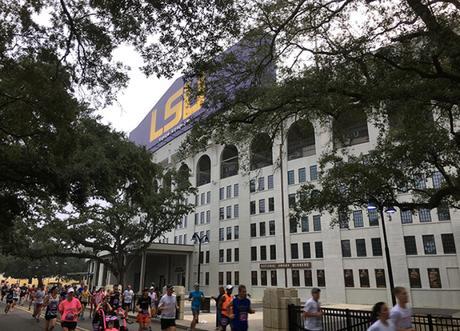
The church of college football: Tiger Stadium (aka “Death Valley”) at mile 5
The highlight of the marathon route, had I not been distracted by the massive football monolith on the opposite side of the street, would have been the 15,000-square foot outdoor tiger enclosure, constructed in 2005 for a reported $3 million. The enclosure’s sole inhabitant is the campus mascot, Mike the Tiger—since 1936 there have been a series of “Mikes” who have called the campus home. Sadly its most recent occupant, Mike VI, lost his battle with sarcoma (soft tissue cancer) in October, and so the habitat currently sits empty.
I’m not an advocate of zoos, and so I was glad not to see another regal animal cooped up in a small space. And I’m not alone—after Mike V’s death in 2007, PETA had apparently urged the LSU chancellor at the time not to bring in a new tiger, a request that was roundly rejected in favor of Mike VI. But in LSU’s defense, Mike VI had been a rescue animal donated by an Indiana-based large cat and carnivore rescue facility, so it’s not like the chancellor sent a campus task force out to the Serengeti to poach a Bengal tiger. Nevertheless, the thought of such a magnificent beast living alone on—of all places—a college campus left me with mixed emotions, and I was admittedly relieved not to see it for myself.
Making a brief detour away from University Lake, we ran on narrow streets that read like a “greatest hits” of U.S. higher education—Cornell, Harvard, Emory, Stanford—past well-maintained homes with immaculately groomed yards and patios set off by white balustrades. Telltale signs of faculty housing.
By the time we rounded the campus and reached the opposite side of the lake, now headed north the way we’d come, the fog had lifted and I could finally appreciate our surroundings. Nutrition-wise I was sticking to a schedule, downing one Clif Shot Blok every 20 minutes and one gel on the hour, a strategy that seemed to be keeping my energy levels stable. I was feeling good, and I continued to pull back on the throttle as I regularly dropped below an 8:00/mile pace.
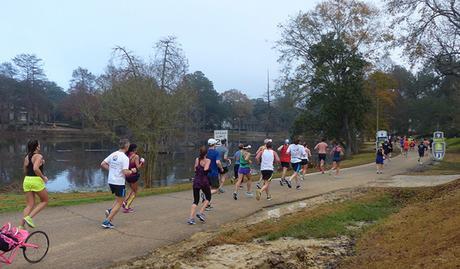
Fog-free mile 9 around University Lake
But no matter how good I felt as I pulled alongside the 3:35 pace group on the narrow lake path, it was tough to appreciate Bon Jovi’s “Livin’ on a Prayer” blasting its time-tested chorus of “WHOAAAAAA, we’re halfway there…” in mile 9. With 17+ miles to go. (This is the running equivalent of an “alternative fact”.)
Entering double digits at mile 10, I passed the bizarre “Supreme Race selfie station”. From what I recall based on a fleeting glimpse, this featured a wooden cutout of a large bag of race primed for picture taking. And you’ll probably be shocked to learn there was no one waiting in line when I passed. No offense to Supreme Rice, I’m sure they make an awesome grain and I appreciate their sponsorship of this event since we couldn’t run without them—but how high on endorphins or Insta-crazed do you have to be to pose in the middle of a race with a fake (or real) bag of rice?
The miles flew by on a fantastic day for running, with long stretches of residential roads featuring pockets of cheer zones, though never any oversized or overly raucous groups of spectators. And now that I think of it, though they’re referenced on the website I don’t recall hearing any live bands along the course, either.
Speaking of spectators, my shout-out for best of the day went to an enthusiastic 4-year-old drill sergeant-in-training, with his blonde crewcut and impassioned cries of “LET’S GO RUN-NERS! LET’S GO RUN-NERS! LET’S GO RUN-NERS!” For a second I thought he might see my smile and tell me to drop and give him 10 pushups. He didn’t miss a beat or pause for breath as I passed, his boisterious chants receding in the distance behind me.
At mile 11 the marathon and half marathon courses diverged, with the half marathon course headed back toward the Capitol and the marathon course continuing east. This splitting of the two courses thinned the crowd (~75% half marathoners, 25% marathoners) dramatically and left me essentially running by myself. Just the way I like it.
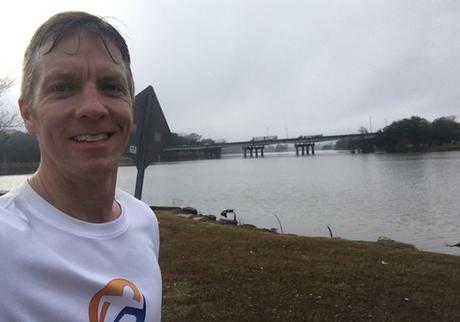
There’s always time during a marathon for a selfie (University Lake, mile 10)
To maintain an aggressive pace
whether naïve or bold,
Leads our story to an ending,
and the ending must be told.
I continued to hit my 8:08 mile paces comfortably as I approached mile 16, the end of my planned 13-mile tempo run. I decided to maintain that comfortable pace beyond mile 16 rather than intentionally slowing down, since the latter ironically struck me as the more laborious option. If I got tired I got tired, and at that point I’d slow down. All I had to do from here was maintain an 8:30/mile pace to ensure an easy sub-3:45.
Through attractive subdivisions we ran, along oak- and magnolia-lined streets decorated with homes whose distinctive architecture hinted at their antebellum roots. The city’s charming Southern architecture helped distract my mind from the mounting mileage.
The more marathons I run, the less likely it becomes I’ll see a new spectator sign that strikes my fancy—and Louisiana was no exception. “Your couch misses you” may have been my favorite of the day, though a shout-out to the lady with the “You run marathons, I watch them on Netflix” sign. And I’ve noticed in the past year that “Run faster, I farted” has become the go-to race day motivation of kids across the country.
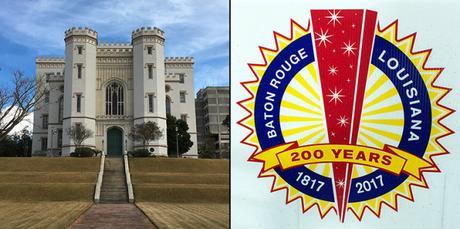
Louisiana’s Old State Capitol—used as such for 60 of the town’s 200 years—is now a National Historic Landmark
“Great job, random stranger!” is one of the more popular spectator signs at any marathon, and I couldn’t help laughing when a runner behind me responded on one occasion with an exuberant shout of “Thanks, random citizen!”
I reached mile 23 before fatigue finally insinuated its way into my quads and hip flexors. Recognizing that I’ve got a lot of racing miles ahead of me in 2017, I consciously slowed to avoid blowing out my legs in my first race of the year. Even so I continued to pass other runners, and I can only recall a single runner passing me in the last 13 miles, with that coming in the final mile. Not since last year’s Los Angeles Marathon had I run a marathon this comfortably. Good to know my legs ain’t broke.
I held off on my last gel until just before the mile 24 aid station, leaving me no choice but to accept a cup of water from a fellow dressed head-to-toe in Green Bay Packers gear. Those same Packers would jettison my Dallas Cowboys from the NFL playoffs on a last-second field goal later in the day. Unfortunately, at mile 24 of a marathon beggars can’t be choosers, so I smiled and thanked him while silently wishing a soul-crushing and season-ending defeat on his team. Apparently he was wishing just a little bit harder.

1/10 of a mile to go with half marathoners on the left, marathoners on the right
Mile 25, and the marathon and half marathon courses merged once again as we turned back toward the Capitol. And here the organizers demonstrated the kind of keen foresight that runners appreciate (and remember), keeping the two courses separated with half marathoners on the left and marathoners on the right. Not that there were many half marathoners remaining after more than 3 hours, but it’s never fun to have to weave tiredly around a pack of shoulder-to-shoulder walkers spread out across the street and oblivious to exhausted runners coming up behind them. It’s a small thing to be sure, but small things add up—and attention to detail is what distinguished the Louisiana Marathon from some other small-town races I’ve run.
The course is almost entirely flat, the most noticeable “hill” being the North Blvd overpass located in mile 2 and—as course layout would have it—mile 26. Still feeling good but ready to be done, I ran step-for-step with another determined fellow as we crossed the overpass and approached the short-but-nasty uphill jag leading to the final turn.
One last surge of adrenaline hit me as we turned up 4th St. into the home stretch, and I could just make out the finish arch faintly visible nearly half a mile away. I’d done what I came here to do, and as I passed the mile 26 marker I soaked up the crowd’s energy and genuinely enjoyed the last 385 yards, returning to the State Capitol in much less of a haze than I’d left it and in a time of 3:31:13, my fastest marathon in nearly two years.
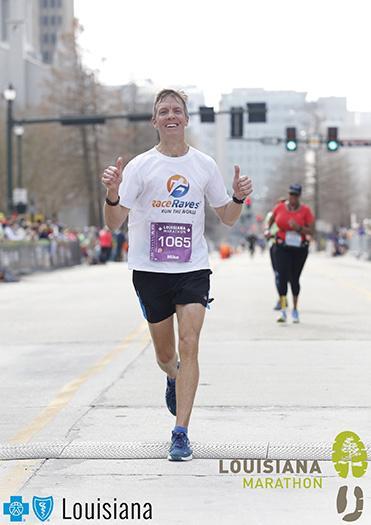
Bienvenue à la ligne d’arrivée! Celebrating a jog well run
I reunited with Katie who had been everywhere as usual, covering the course almost as efficiently as the fog. We compared notes and cheered in other finishers before slowly diffusing toward the finish festival. It’s not often I look forward to a post-race party, but I’d heard and read so much about Louisiana’s hospitality that I was eager to see what all the fuss was about.
And the festival didn’t disappoint, with food and vendor booths set up around the perimeter of State Capitol Park, giving finishers a place to stretch, lounge and munch while a live band entertained with the musical stylings of the Deep South. If you’re wondering how two vegetarians found their way in a state known for meat-heavy dishes like jambalaya and crawfish étouffée, the Whole Foods Vegan Village featured a variety of tasty options, even if they did run out of several items early. And the beer was flowing freely for carnivores and herbivores alike.
On the leisurely walk back to our hotel we stopped to chat with Jim, a fellow finisher clad brightly in INKnBURN gear, hot pink headband and rainbow calf sleeves. Jim also happened to be the singer of that morning’s National Anthem. We chatted briefly about his own 50 states quest (running and singing), and he mentioned that he celebrates every finish with a post-race headstand. Clearly the man is—in his own words—not a wallflower.
Upon learning he’d be running SoCal’s own Surf City on Super Bowl Sunday, we promised to keep an eye out for each other. And as luck would have it, three weeks later we’d reunite after crossing the Surf City finish line within seconds of each other, Jim finishing the half marathon (which started 90 minutes later than the full) while I wrapped up my second marathon of the young year. It’s a small world, after all.
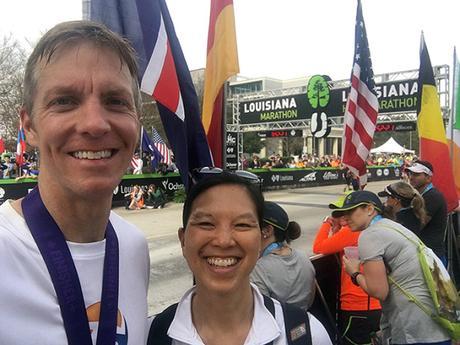
Parting ways with Jim, we’d have one last acquaintance to make before saying our goodbyes to Baton Rouge. As we strolled down 4th Street away from the finish line, I saw slowly approaching the distinctive stride of marathoning legend Larry Macon, accompanied by two other runners. His labored stride—suggestive of a man carrying a bag of rocks slung over one shoulder—betrayed the accumulated miles of a man who’s run over 1,800 marathons in his 72 years. His face, however, told a different story.
“Nice to meet you, Larry!” I called, stopping to applaud. “You too!” he smiled back as he shuffled past without breaking stride. As we watched, his blue “LARRY – 1,800 Marathons and counting” vest faded into the distance, passing the mile 26 marker en route to the same finish line I’d crossed nearly 3½ hours earlier. And the question flashed across my mind—will I still be running 26 miles at a time 26 years from now? It’s tough to imagine, but one thing is certain: I won’t need four digits to count ‘em up.
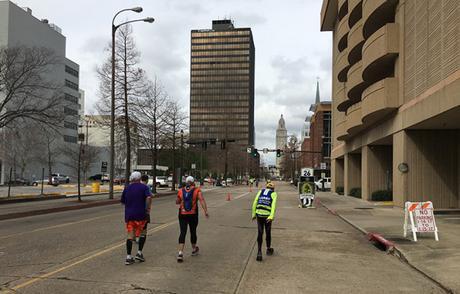
Larry Legend and friends close in on mile 26 and the finish line
Few of us will ever catch a touchdown or hit a home run or dunk a basketball—but anyone can cross a finish line. If an indomitable 7–year-old with cerebral palsy can do it, and a 72-year-old can do it over 1,800 times while still smiling, then there’s no excuse for sitting on the sidelines. You don’t have to run marathons, or even half marathons, but the cliché is cliché for a reason: Where there’s a will, there almost always is a way. In an increasingly bitter and divided country, running is everyone’s sport. As the nation continues to accumulate negative energy, challenging yourself to reach your personal finish line regardless of obstacles—physical or otherwise—will always be among the most positive things you can do to improve yourself, inspire others and make a difference.
Because there’s nothing like a good run to lift the fog.
The lesson learned? Keep this in mind:
though (s)he be young or old,
A runner’s story may just be
the best that’s ever told.

BOTTOM LINE:
Whether you’re a 50 stater
or just seeking a great race,
I can tell you with conviction
Baton Rouge is just the place.
With Deep South hospitality
and lagniappe to spare,
you get the sense the folks in charge
do really give a care.
Logistics are easy, the course shows off
the campus and the town,
and ‘cross the finish line awaits
the best post-race fest around.
Free photos, awesome volunteers,
aid stations laid out well—
if the devil’s in the details
Louisiana gives ‘em hell.
Sure, the swag may not excite
with simple shirt and bling.
But ask me would I run again?
No doubt—and that’s the thing.
So a final word for runners
looking for a top-notch show:
Baton Rouge, Louisiana
is the place you want to geaux!
#GeauxRunLA
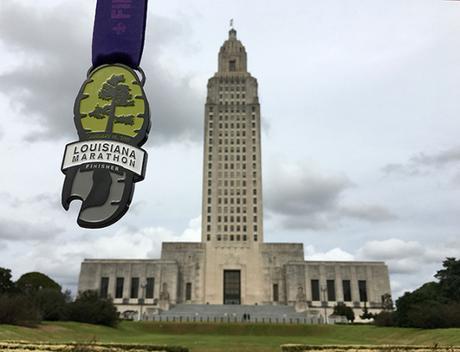
Baton Rouge wins the medal for tallest state capitol building in the nation
RaceRaves rating:
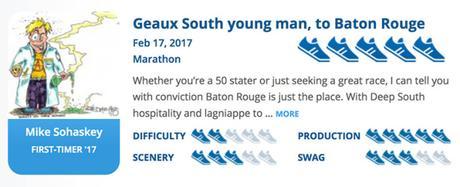
FINAL STATS:
January 15, 2017 (start time 7:00am)
26.38 miles in Baton Rouge, LA (state 15 of 50)
Finish time & pace: 3:31:13 (first time running the Louisiana Marathon), 8:01/mile
Finish place: 76 overall, 8/71 in M 45-49 age group
Number of finishers: 951 (537 men, 414 women)
Race weather: cool, cloudy & foggy at the start (temp 61°F), cool & cloudy at the finish, humid throughout
Elevation change (Garmin Connect): 170 ft ascent, 173 ft descent
